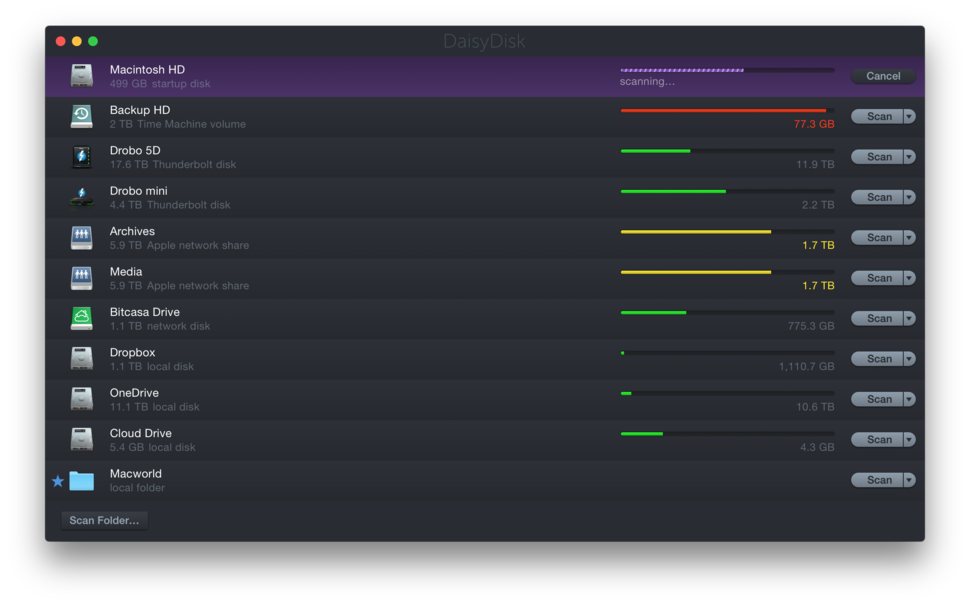Macworld Editors’ Choice Award Winner; Lifehacker: «DaisyDisk is a beautiful disk space analyzer.» 9To5Mac: «DaisyDisk, chosen by Apple as a Mac App Store ‘essential’, provides a cleaner and more interactive circular interface for visualizing Mac’s. Why is DaisyDisk great to utilize, though, is how tempting the software is. It favorably encourages that you explore around your drive, and makes this simple part of keeping your Mac an authentic pleasure. Installing DaisyDisk. DaisyDisk is a cinch to set up; simply pull the iphone app to the Applications folder. Mar 11, 2010 DaisyDisk is a great tool that allows you to take control of your HDD. The process is very simple and the graphic representation helps you actually make an idea about what you are doing with your.
LFO will use to set up rhythmic sequences or custom wave-shapes. Modulation carried to high-quality LFOs which can be synchronized to your track’s BPM. /electrax-vst-full-crack.html.

| Developer(s) | Software Ambience |
|---|---|
| Initial release | 2008 |
| Stable release | 4.10 (March 8, 2020; 41 days ago[1]) [±] |
| Operating system | macOS |
| Available in | English, German, French, Italian, Russian, Simplified Chinese, Traditional Chinese, Japanese, Swedish, Spanish, Polish[2] |
| Type | Disk space analyzer |
| Website | daisydiskapp.com |
| Usage | |
DaisyDisk is a paid disk space analyzer for macOS.[3] It displays a sunburst diagram of files on a hard drive to help with the location or deletion of large files.[4] It can display previews of files using Quick Look.[5][6][7] It also allows the user to look at the file directly in Finder, in order to delete it or move it elsewhere.[8]
Daisydisk Review Macworld Pro
History[edit]
DaisyDisk was started in late 2008 by interaction designer Taras Brizitsky and programmer Oleg Krupnov. They built the codebase from scratch to try to achieve higher speeds than similar programs. They decided to use a sunburst diagram as it is perceived better than other ways of visualizing data (such as treemaps).[9]
Features[edit]
DaisyDisk needs to scan the disk to create a map of its files and folders. Once the initial scan is completed, DaisyDisk keeps all displayed information up to date and reflects all changes to disk in real-time. DaisyDisk can scan multiple disks in parallel.
With v4.5[10] of DaisyDisk, support for APFS was added.[11]
Interface[edit]
DaisyDisk displays the contents as a color-coded sunburst diagram, resembling the petals of a daisy.[12]Download zebra 2 vst. The interface places the root of the hard drive at the center of this daisy, and displays a hierarchical structure of that hard drive's file system that radiates from that center. This daisy is color-coded to differentiate between folders, while files themselves are always displayed as gray. In the right sidebar of the interface, DaisyDisk also provides a legend for these color codes. When hovering over a file or folder, the right sidebar of the interface updates with contextual information such as the file or folder name and their absolute path.[13] When clicking on a folder on the daisy, a new daisy is displayed with the chosen folder as its root. The interface shows a 'breadcrumb trail' of the current folder right above the sunburst diagram.[6]
DaisyDisk provides a Trash-like collector icon in the lower left of its interface where files and folders can dragged and dropped for deletion.[13]
As of DaisyDisk v3, a specialized version of the app exists for Mac users with Retina Displays.[14]
Integration[edit]
One of the ways DaisyDisk integrates with the Mac features is through its support of the Quick Look function, which is included in Mac OS X v10.5 'Leopard' and later. Hovering over any file or folder in DaisyDisk's interface and pressing space bar utilizes Quick Look and displays additional information about that file or folder in regards to its location and contents.[12]
References[edit]

Daisydisk For Pc
- ^'DaisyDisk Release Notes'. Retrieved 9 March 2020.
- ^'DaisyDisk Blog'. Software Ambience.
- ^'DaisyDisk 4.6.2 free download for Mac'. MacUpdate. Retrieved 19 June 2018.
- ^'DaisyDisk 4 Review'. Macworld. Retrieved 19 June 2018.
- ^'DaisyDisk: Tom's Mac Software Pick'. Lifewire. Retrieved 11 March 2019.
- ^ ab'DaisyDisk: Futuristic Data Visualization'. Mac.AppStorm. Retrieved 20 June 2018.
- ^'How to identify the biggest space wasters on your Mac with DaisyDisk'. iDownloadBlog. Retrieved 19 June 2018.
- ^'Make Your HD Bigger with DaisyDisk for Mac [Review]'. Cult of Mac. Retrieved 11 March 2019.
- ^'An Evaluation of Space-Filling Information Visualizations for Depicting Hierarchical Structures'(PDF). Georgia Institute of Technology. Retrieved 2 June 2010.
- ^'Top 5 questions about APFS and macOS High Sierra asked by Mac users'. DaisyDisk Blog. Retrieved 20 June 2018.
- ^'How to free up disk space in macOS High Sierra'. Cult of Mac. Retrieved 20 June 2018.
- ^ ab'Review: DaisyDisk: Disk Visualization and Analyzer Tool for the Mac'. aboutTechnology. Retrieved 13 November 2014.
- ^ ab'Make Your HD Bigger with DaisyDisk for Mac [Review]'. Cult of Mac. Retrieved 13 November 2014.
- ^'DaisyDisk Blog'. Software Ambience. 7 September 2013. Retrieved 5 January 2019.